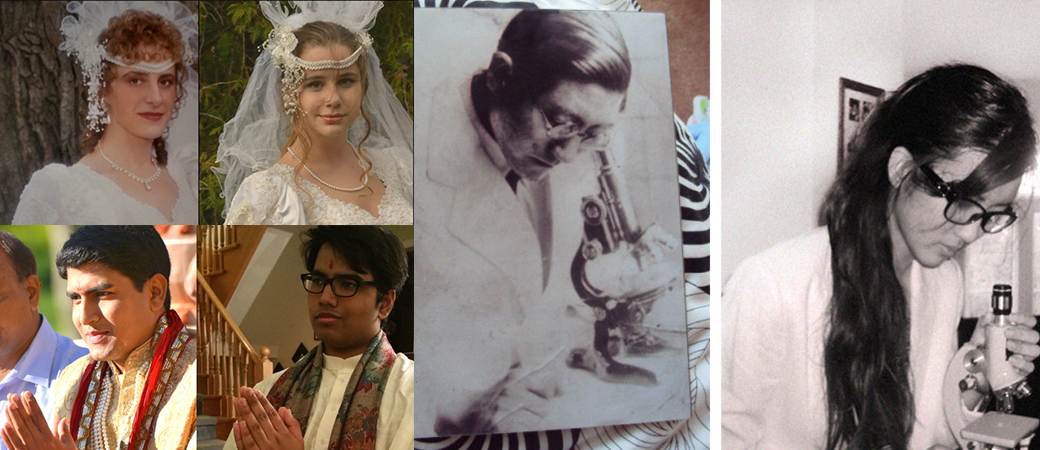
Students following Cashel’s instruction to recreate a photo of an older relative.
Two visual arts classes at our school were studying artists that work with “Systems,” including Julie Mehretu, Alan McCollum, Micah Lexier, and Sol LeWitt. So my class began exploring the project Learning to Love You More by artists Miranda July and Harrell Fletcher.
From 2002-2009, anyone could complete one of the seventy assignments created by the artists and send in documentation of their having completed it in the form of a photograph, text, or video. ”Like a recipe, meditation practice, or familiar song, the prescriptive nature of these assignments was intended to guide people towards their own experience.” The work of more than 8,000 participants who completed the tasks was posted online.
Based on Learning to Love You More, this collaborative creative exercise can be done independently to spark inspiration (although you’ll need at least one partner), or in a classroom to engage students in creating their own connections between following instructions and the instructions themselves.
Prior to embarking on the assignment, I also read a few of Yoko Ono’s haiku-like instructions from her 2013 book Acorn to the students:
Listen to what the next person is thinking.
Listen to what the person in the next house is thinking.
Listen to what the person in another city is thinking.
Listen to what the person in another country is thinking.
Tell us what you’ve heard.
Step 1: As a warm-up, write an instruction to be followed by someone else. Make sure your instructions include an aspect of documentation that can be shared after the instruction has been followed (for example, “take a photograph,” “write a caption,” or “draw”). Then, find someone else’s instruction and follow it.
For the students in my class, this idea of systems and instructions was carried over into their studio work, where the students were required to paint according to systems or instructions that informed their work.
Step 2: Create a chain reaction by passing your instructions and the instructions you’ve followed onto others. Share it with the Internet by posting it on your blog or social media.
Our class collaborated with another class, led by teacher Jenna Edwards, to create a Padlet that invited students throughout the school and in art classes across the country to follow our instructions or write their own.
Some good examples of my class’ instructions included:
- Pick up a book you would never have thought of reading and flip to page 74. Take 5 nouns and 3 verbs and do a drawing in relation. —Zi Lin
- Take a picture of your favorite stuffed animal/toy from childhood and write a memory you had with it. —Nicolle
- Take a picture of something you see at home everyday, but you’re not quite sure where it came from, it’s always just been there. —Martha
- Take a photo of your favorite childhood item next to your current favorite item and write a short caption comparing the two. —Bradley
- Choose something unpleasant you see everyday. Do something about it to make it more pleasant, then take a picture of it. —Jody
- Choose something you do everyday as part of a routine and do it differently. Take a picture and write a short caption about it. —Clarence
- Find an animal (your pet, outdoors, Google). Draw it, and annotate what you think it might be saying. —Jessica
Some good examples of students following each other’s instructions were:
Draw yourself in your favorite TV show or book. Don’t use an eraser. —Jonna
Ryan’s Sterling Archer. “Lana…Lana!…LANA!!!……………………DAAAANGERZONE”
Zi lin’s Steven universe.
Harsha’s Community – Troy and (me) in the moooorning
Recreate a photo of an older relative. —Cashel
Jessica and her grandpa.
Harsha, recreating his cousin’s puja before his cousin’s wedding photo.
Martha, recreating her mom’s wedding photo.
Remove the contents of any container, box, or bag. Rearrange them to form an image and document it with a photo. —Emilia
By Aisha.
By Sarah.
By Jordan.
One year, we also did a collaboration on instructions with classes led by fellow ART21 Educators across the country. My students wrote instructions for and followed instructions written by students in Jack Watson’s class at Chapel Hill High School in North Carolina, and Joe Fusaro’s class at Nyack High School in New York. We found an exchange of instructions—between classes, between schools—is a tangible, interactive way to build and deepen a student’s understanding of others and self.
Follow one of our instructions and share it online, or start your own method of collecting and sharing instructions. For more on systems-based collaborative creation processes, read about artist Nathan Lane who started Telephone: An International Art Experiment, and Anne Clyne, a composer who creates with images.